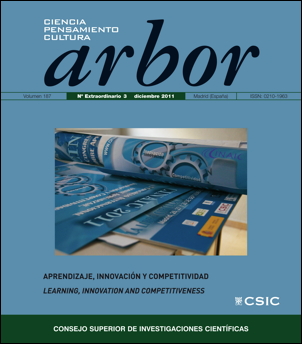Learning entrepreneurship at universities
DOI:
https://doi.org/10.3989/arbor.2011.Extra-3n3131Keywords:
Entrepreneurship education, entrepreneurship at universities, entrepreneurship learningAbstract
This paper aims to think about the suitability of different pedagogical approaches for teaching entrepreneurship in universities. The major challenge in relation to entrepreneurship education is the need to balance the training in business knowledge needed for the exploitation of entrepreneurial opportunities with the training in the “art” of being an entrepreneur needed for the exploration of entrepreneurial opportunities. The main competences related to the “soft” side of entrepreneurial capabilities are creativity and social capabilities. Two teaching methods are presented which overcome this challenge and can facilitate teaching entrepreneurship at universities.
Downloads
References
Bager, T. (2011): “Entrepreneurship Education and new venture creation: a comprehensive approach”, K. Hindle y K. Klyver (Eds.), Handbook of research on new venture creation, Edgar Elgar, Cheltenham, UK., pp. 299-315.
Bird, B. J. (2002/2003): “Learning entrepreneurship competences: The self-direct learning approach”, International Journal of Entrepreneurship Education, 2 (1), pp. 41-59.
Candy, P. C. (1991). Self-direction for lifelong learning: A comprehensive guide to theory and practice, San Francisco: Jossey-Bass.
EU (Comisión Europea): Dirección electrónica: http://ec.europa.eu Fiet, J. (2000): “The theoretical side of teaching entrepreneurship”, Journal of Business Venturing, 16, 1-24.
Garavan, T. N. y O’Cinneide, B. (1994): “Entrepreneurship education and training programmes: A review and evaluation - Part 2”, Journal of European Industrial Training, 18 (11), pp. 13-22. http://dx.doi.org/10.1108/03090599410073505
GEM (Global Entrepreneurship Monitor)(2010): Informe GEM España 2010. Obtenido en: http://www.ie.edu/gem/img/informes/61.pdf.
Jack, S. L. y Anderson, A. R. (1999): “Entrepreneurship education within the enterprise culture. Producing reflective practitioners”, International Journal of Entrepreneurial Behaviour & Research, 5 (3), pp. 110-125. http://dx.doi.org/10.1108/13552559910284074
Kor, Y. Y. y Mahoney, J. T. (2004). Edith Penrose’s (1959): “Contributions to the resource-based view of the firm”, Journal of Management Studies, 41 (1): 183-91. http://dx.doi.org/10.1111/j.1467-6486.2004.00427.x
López, F. (2005): Metodología participativa en la enseñanza Universitaria, Narcea. Observatorio UJI (Universitat Jaume I de Castellón): http://www.uji.es/CA/serveis/ocie/acil/prog/obser/esp/
OCDE (Organisation for Economic Co-operation and Development): Dirección electrónica: http://www.oecd.org.
Penrose E. (1995): “Research on the business firm limits to the growth and size of firms”, The American Economic Review, 45 (2), pp. 531-543.
Shane, S. y Venkatraman, S. (2000): “The promise of entrepreneurship as a field of research”, Academy of Management Review, 25 (1), pp. 217-26.
Zabalza, M. (2003-2004): Innovación en la enseñanza universitaria, Contextos Educativos, pp. 113-136.
Downloads
Published
How to Cite
Issue
Section
License
Copyright (c) 2011 Consejo Superior de Investigaciones Científicas (CSIC)

This work is licensed under a Creative Commons Attribution 4.0 International License.
© CSIC. Manuscripts published in both the printed and online versions of this Journal are the property of Consejo Superior de Investigaciones Científicas, and quoting this source is a requirement for any partial or full reproduction.
All contents of this electronic edition, except where otherwise noted, are distributed under a “Creative Commons Attribution 4.0 International” (CC BY 4.0) License. You may read the basic information and the legal text of the license. The indication of the CC BY 4.0 License must be expressly stated in this way when necessary.
Self-archiving in repositories, personal webpages or similar, of any version other than the published by the Editor, is not allowed.














